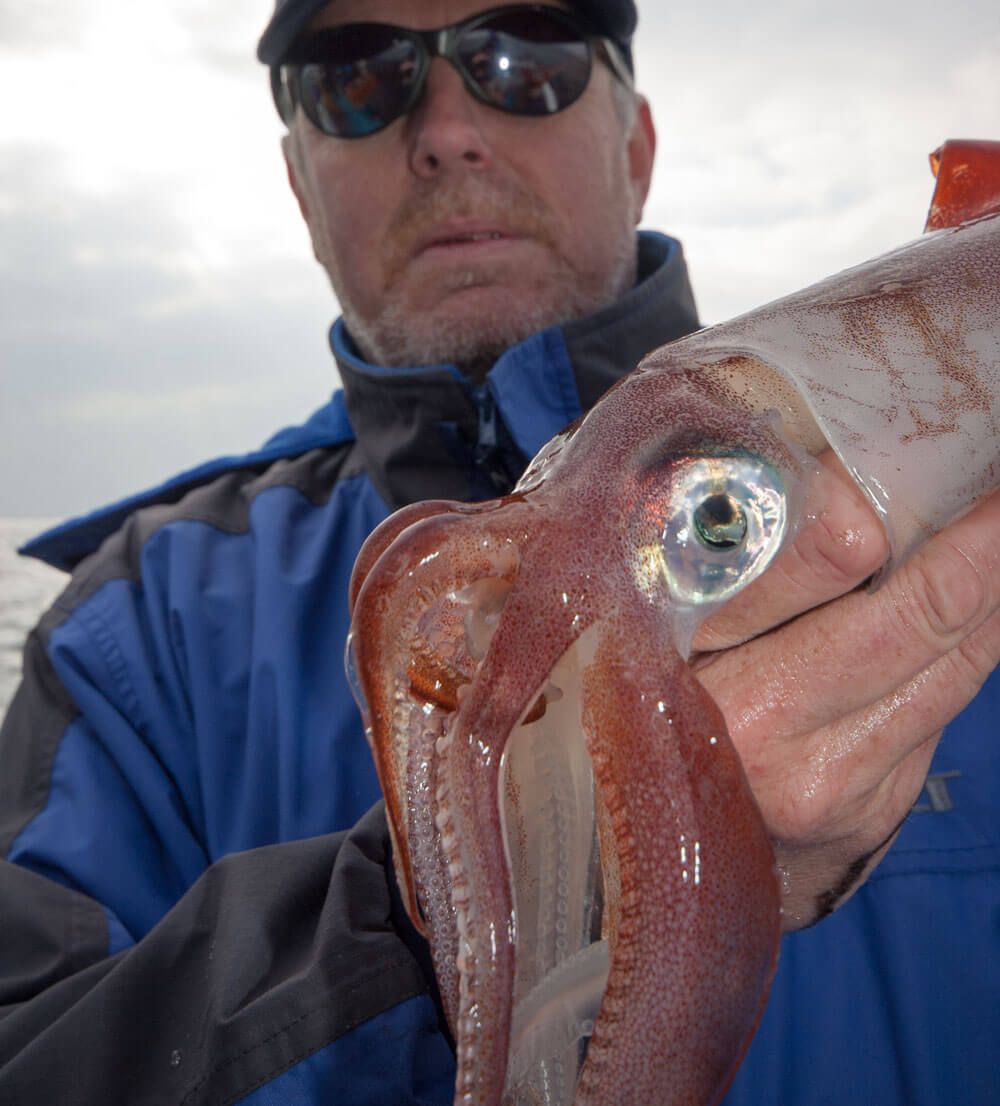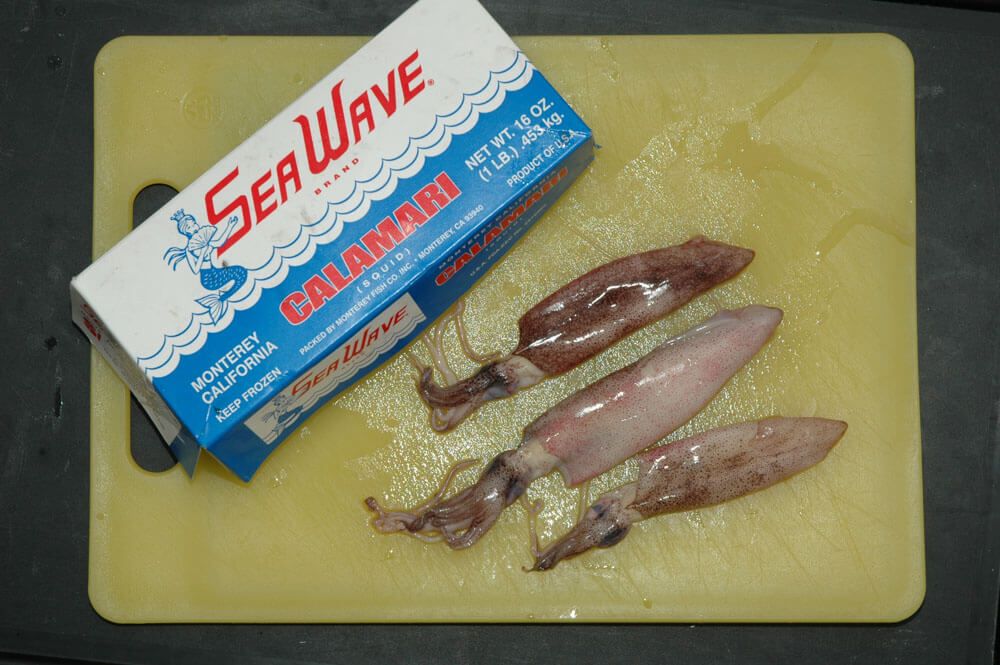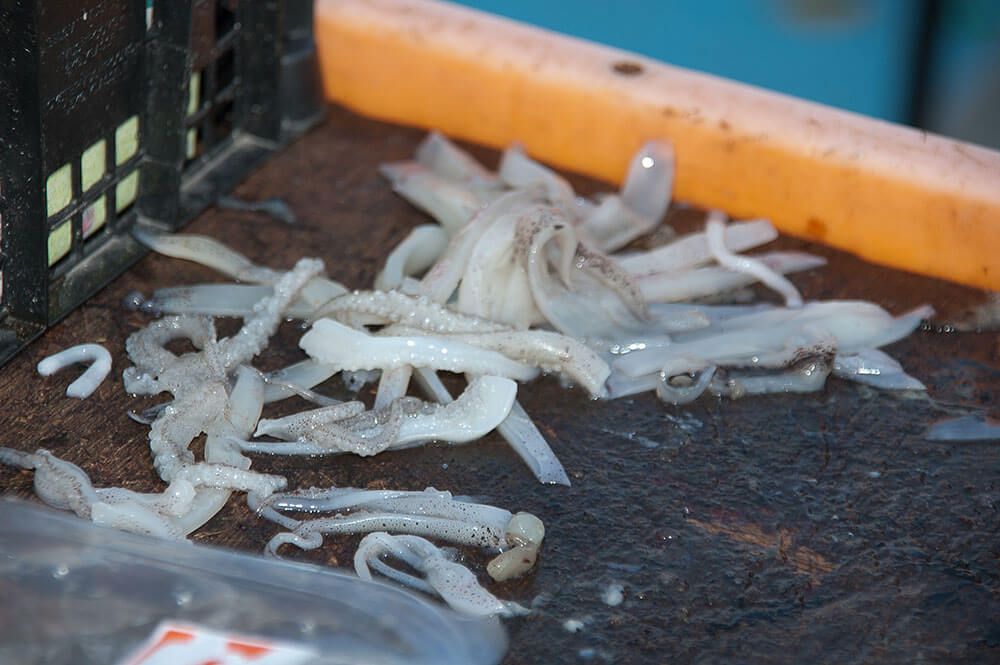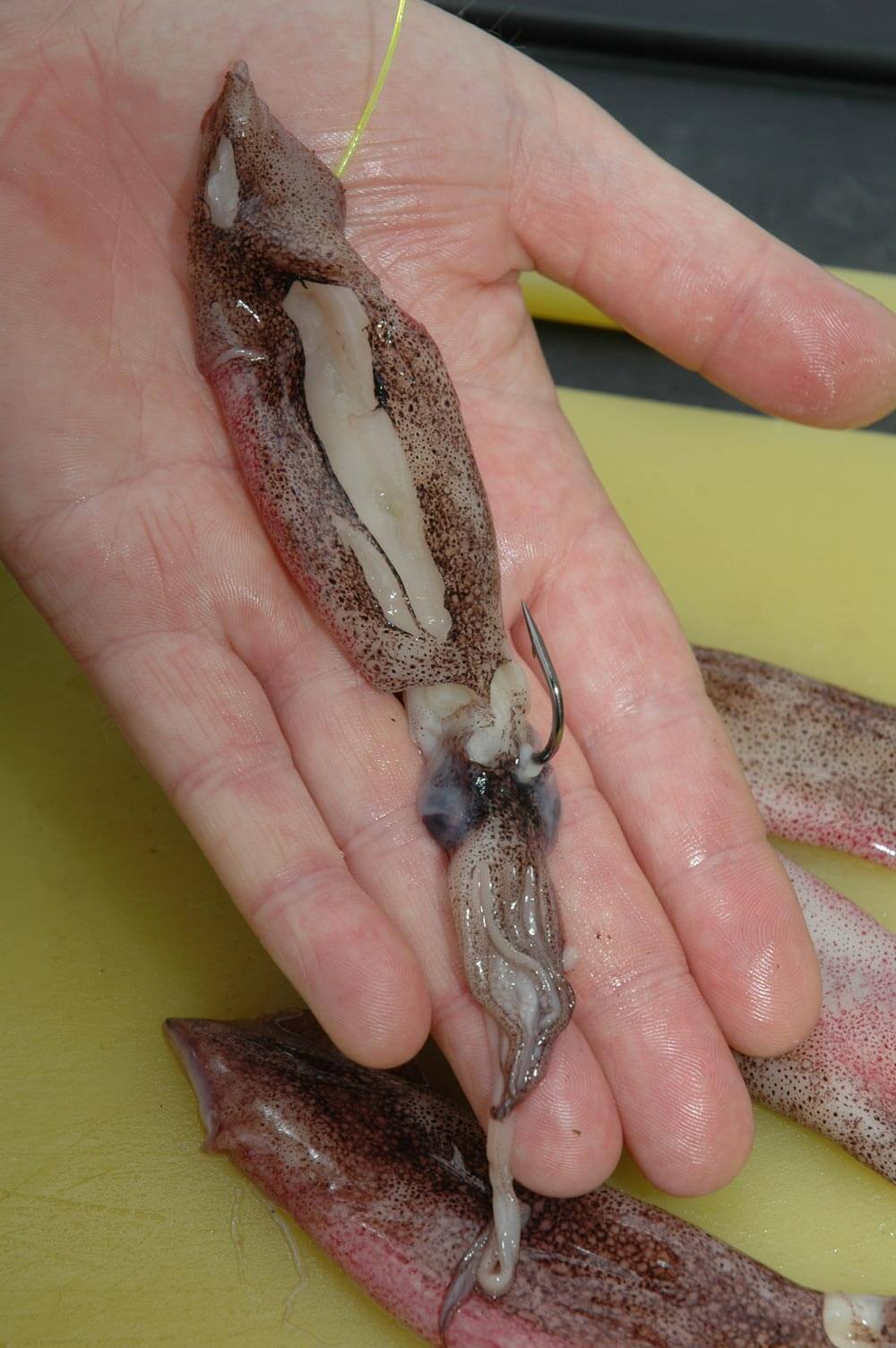Confusion exists in telling octopus from the squids and cuttlefish. The squid and cuttlefish have five pairs of tentacles, four of equal length and one longer pair. The octopus has eight tentacles all the same length.
The most often used squid for bait is not a resident of home waters at all. This is the Californian (Chinese squid) or Kalamari after the Spanish word calamar. These are smaller (averages between 4 " and 6") than the common squid which can grow to a full 24" in overall length. This is sold for restaurant and domestic kitchen use and therefore is readily available and cheap.
HABITAT
All three species are commonest in deep offshore waters, but the cuttle and squid are sometimes washed ashore and maybe occasionally frequent shallow bays.
Found all around the UK coast, but hotspots occur off the west coast of Ireland, the English Channel to North Wales and off Scotland's west coast.
SEASON
Can occur throughout the year, but most common during the summer and autumn period.
COLLECTION
Occasionally octopus will grab a bottom fished fish bait when drift fishing with the tide, but these are fairly rare captures and this is not a reliable way to catch bait.
There are purpose made weighted plastic squid hooks available which are actually shaped similar to an upside down ice cream cone, the rim of the cone itself being ringed with upward facing metal spikes. These are worked like a jig up and down under the boat though a shoal of squid. When a squid grabs the lure it becomes impaled on the spikes and can be reeled in.
Again, the squid jig is not a recognised way of getting bait and tends to be an opportunist method in this country, at best.

HOW TO BUY SQUID
The best way to buy squid is not so called fresh from the fishmonger's slab as this is more than likely frozen stuff that's been defrosted. Kalamari is supplied in frozen blocks of 1lb and 5lbs in weight. This is the best way to guarantee freshness. These are available through a fishmonger. Keen anglers out two or three times a week wisely visit their local wholesale market early in the morning and buy a minimum of a couple of 5lb blocks.
The 1lb blocks are ideal for long sessions for up to two anglers, but the 5lb blocks are the cheapest way to buy squid, but the block then needs separating in to trip sized units.
Do this by partially allowing the block to defrost, but keep an ey/div>e on the melting process and start to break up the squid by hand as they are partially thawed. Split them into packets of say 4 to 6 squid which will see you through a session and re-freeze them using sealable freezer bags to stop freezer burn.
Buying from a busy tackle shop is fairly safe as their bait has a rapid changeover. It's wise to use a tackle shop that stocks quality branded baits like Predator Baits and Ammo that give excellent results. Be less certain of squid packed by the tackle shop themselves in unbranded bags.
When checking frozen squid for freshness, it's often written that squid is no good if the flesh is stained pink. To some extent this is true, but squid can carry a natural pinky staining that many anglers confuse as being a sign that the bait is past it's best. It's squid with a really deep pinky red stain throughout the whole body that should raise your suspicions as this is a sign that they have been repeatedly frozen and defrosted.
Another thing to look for is a quantity of drained stained frozen inky water in the base of the bag. Usually a result of too long a time lapse between the squid's death and being frozen, but also due to continually freezing and defrosting the bait again.
The best way to verify the freshness is to go back to basics and give the bait the once over with the trusty nostrils. If the bait smells strong in any way, then discard it. Fresh squid is almost smell free other than a slight obvious sea smell.

TRANSPORTATION
Small Kalamari's tend to thaw quite quickly being fairly small, but bigger squid do take a while, even in summer. However, it pays to carry the squid as other baits in a proper cool box with a couple of ice packs placed on the top to keep the temperature down.
When you get to the venue, open the first pack and remove just a couple of squid leaving the others in the cool box. Take only what you'll immediately need. If you take a quantity of squid out and leave it in the sun, as the bait defrosts the draining juices can quickly turn in the heat and will contaminate the squid flesh.
PRESENTATION
When preparing squid for cutting into strips it's easier to work as follows.
Cut off the head of the squid to leave the tunnel shaped body cavity. Now cut down the length of the body so that the sides open up and fall flat leaving a roughly square shape. Use the knife blade to scrape away the guts and also remove the clear coloured backbone. It's now easy to cut thin strips.
The strips vary from 1.5" x 0.5" for dabs and smaller species, to 6" x 2" for dogfish etc. Nick the small strips once over the hook so that they move with the tide, but the larger strips are best folded over the hook point twice to create a more bulky bait.

Squid strips are excellent for tipping off lug and rag baits when after cod and whiting, and they also work well in conjunction with mackerel and herring when chasing rays.
Alternatively, having removed the head, leave the rear end of the body closed, but remove the guts etc, with your finger, then place the hook down inside the body bringing the point out through the skin at the base. Fill the open ended cavity with mackerel flesh, lugworm, mussel etc, and sew up the open end securing the whole package to the hidden hook shank inside with elastic thread. Now pierce the skin a few times with the tip of a knife to release the juices.
This filled body presentation is excellent for big fish like cod, bass, rays and huss, especially when crab are chewing normal baits to bits as they find the squid skin tough and take time to expose the contained lug, fish etc..
When using whole Kalamari it's easier to use a baiting needle that fits over the hook point pushing the bait down the needle body first and then through the head bring the hook out between the eyes. To stop the body collapsing down in to the gape of the hook you can secure it with elastic thread bound over the line above the hook.

The large UK squid are best cut in to chunks or long strips, though whole cuttlefish make a good conger and cod bait in deep water around wrecks. Presentation is the same, but the hooks need to be Mustad O/Shaughnessy 10/0's. Porbeagle and blue shark will also hit a whole squid bait suspended within 30' of the surface, especially in the dusk period when squid shoals tend to rise to near surface level.
During the post Christmas period, many big cod have been taken fishing three Kalamari's on a pennel rig of 8/0 hooks. The first squid goes on the top hook leaving the hook point exposed, the second squid is trapped up against the base of the first, and the last squid goes on the base hook. Now wrap the whole package in elastic thread to secure it.
Squid is a bait that can be left out longer than most others, for while we think it has little smell fish obviously know different and fish find squid baits that have been down in the deeps well over a hour or more.
SQUID FACTS AND TIPS
Squid takes a dye very well. The ones being used are food colourants and these have been found to effective for tipping other baits used in red, gold and yellow, but more on this in a future article.
While the body flesh makes an excellent bait, the head itself proves disappointing in comparison, though dogfish find it palatable. The tentacles also prove a poor bait, even when cut in to short sections.
The most often used squid for bait is not a resident of home waters at all. This is the Californian (Chinese squid) or Kalamari after the Spanish word calamar. These are smaller (averages between 4 " and 6") than the common squid which can grow to a full 24" in overall length. This is sold for restaurant and domestic kitchen use and therefore is readily available and cheap.
HABITAT
All three species are commonest in deep offshore waters, but the cuttle and squid are sometimes washed ashore and maybe occasionally frequent shallow bays.
Found all around the UK coast, but hotspots occur off the west coast of Ireland, the English Channel to North Wales and off Scotland's west coast.
SEASON
Can occur throughout the year, but most common during the summer and autumn period.
COLLECTION
Occasionally octopus will grab a bottom fished fish bait when drift fishing with the tide, but these are fairly rare captures and this is not a reliable way to catch bait.
There are purpose made weighted plastic squid hooks available which are actually shaped similar to an upside down ice cream cone, the rim of the cone itself being ringed with upward facing metal spikes. These are worked like a jig up and down under the boat though a shoal of squid. When a squid grabs the lure it becomes impaled on the spikes and can be reeled in.
Again, the squid jig is not a recognised way of getting bait and tends to be an opportunist method in this country, at best.

HOW TO BUY SQUID
The best way to buy squid is not so called fresh from the fishmonger's slab as this is more than likely frozen stuff that's been defrosted. Kalamari is supplied in frozen blocks of 1lb and 5lbs in weight. This is the best way to guarantee freshness. These are available through a fishmonger. Keen anglers out two or three times a week wisely visit their local wholesale market early in the morning and buy a minimum of a couple of 5lb blocks.
The 1lb blocks are ideal for long sessions for up to two anglers, but the 5lb blocks are the cheapest way to buy squid, but the block then needs separating in to trip sized units.
Do this by partially allowing the block to defrost, but keep an ey/div>e on the melting process and start to break up the squid by hand as they are partially thawed. Split them into packets of say 4 to 6 squid which will see you through a session and re-freeze them using sealable freezer bags to stop freezer burn.
Buying from a busy tackle shop is fairly safe as their bait has a rapid changeover. It's wise to use a tackle shop that stocks quality branded baits like Predator Baits and Ammo that give excellent results. Be less certain of squid packed by the tackle shop themselves in unbranded bags.
When checking frozen squid for freshness, it's often written that squid is no good if the flesh is stained pink. To some extent this is true, but squid can carry a natural pinky staining that many anglers confuse as being a sign that the bait is past it's best. It's squid with a really deep pinky red stain throughout the whole body that should raise your suspicions as this is a sign that they have been repeatedly frozen and defrosted.
Another thing to look for is a quantity of drained stained frozen inky water in the base of the bag. Usually a result of too long a time lapse between the squid's death and being frozen, but also due to continually freezing and defrosting the bait again.
The best way to verify the freshness is to go back to basics and give the bait the once over with the trusty nostrils. If the bait smells strong in any way, then discard it. Fresh squid is almost smell free other than a slight obvious sea smell.

TRANSPORTATION
Small Kalamari's tend to thaw quite quickly being fairly small, but bigger squid do take a while, even in summer. However, it pays to carry the squid as other baits in a proper cool box with a couple of ice packs placed on the top to keep the temperature down.
When you get to the venue, open the first pack and remove just a couple of squid leaving the others in the cool box. Take only what you'll immediately need. If you take a quantity of squid out and leave it in the sun, as the bait defrosts the draining juices can quickly turn in the heat and will contaminate the squid flesh.
PRESENTATION
When preparing squid for cutting into strips it's easier to work as follows.
Cut off the head of the squid to leave the tunnel shaped body cavity. Now cut down the length of the body so that the sides open up and fall flat leaving a roughly square shape. Use the knife blade to scrape away the guts and also remove the clear coloured backbone. It's now easy to cut thin strips.
The strips vary from 1.5" x 0.5" for dabs and smaller species, to 6" x 2" for dogfish etc. Nick the small strips once over the hook so that they move with the tide, but the larger strips are best folded over the hook point twice to create a more bulky bait.

Squid strips are excellent for tipping off lug and rag baits when after cod and whiting, and they also work well in conjunction with mackerel and herring when chasing rays.
Alternatively, having removed the head, leave the rear end of the body closed, but remove the guts etc, with your finger, then place the hook down inside the body bringing the point out through the skin at the base. Fill the open ended cavity with mackerel flesh, lugworm, mussel etc, and sew up the open end securing the whole package to the hidden hook shank inside with elastic thread. Now pierce the skin a few times with the tip of a knife to release the juices.
This filled body presentation is excellent for big fish like cod, bass, rays and huss, especially when crab are chewing normal baits to bits as they find the squid skin tough and take time to expose the contained lug, fish etc..
When using whole Kalamari it's easier to use a baiting needle that fits over the hook point pushing the bait down the needle body first and then through the head bring the hook out between the eyes. To stop the body collapsing down in to the gape of the hook you can secure it with elastic thread bound over the line above the hook.

The large UK squid are best cut in to chunks or long strips, though whole cuttlefish make a good conger and cod bait in deep water around wrecks. Presentation is the same, but the hooks need to be Mustad O/Shaughnessy 10/0's. Porbeagle and blue shark will also hit a whole squid bait suspended within 30' of the surface, especially in the dusk period when squid shoals tend to rise to near surface level.
During the post Christmas period, many big cod have been taken fishing three Kalamari's on a pennel rig of 8/0 hooks. The first squid goes on the top hook leaving the hook point exposed, the second squid is trapped up against the base of the first, and the last squid goes on the base hook. Now wrap the whole package in elastic thread to secure it.
Squid is a bait that can be left out longer than most others, for while we think it has little smell fish obviously know different and fish find squid baits that have been down in the deeps well over a hour or more.
SQUID FACTS AND TIPS
Squid takes a dye very well. The ones being used are food colourants and these have been found to effective for tipping other baits used in red, gold and yellow, but more on this in a future article.
While the body flesh makes an excellent bait, the head itself proves disappointing in comparison, though dogfish find it palatable. The tentacles also prove a poor bait, even when cut in to short sections.

